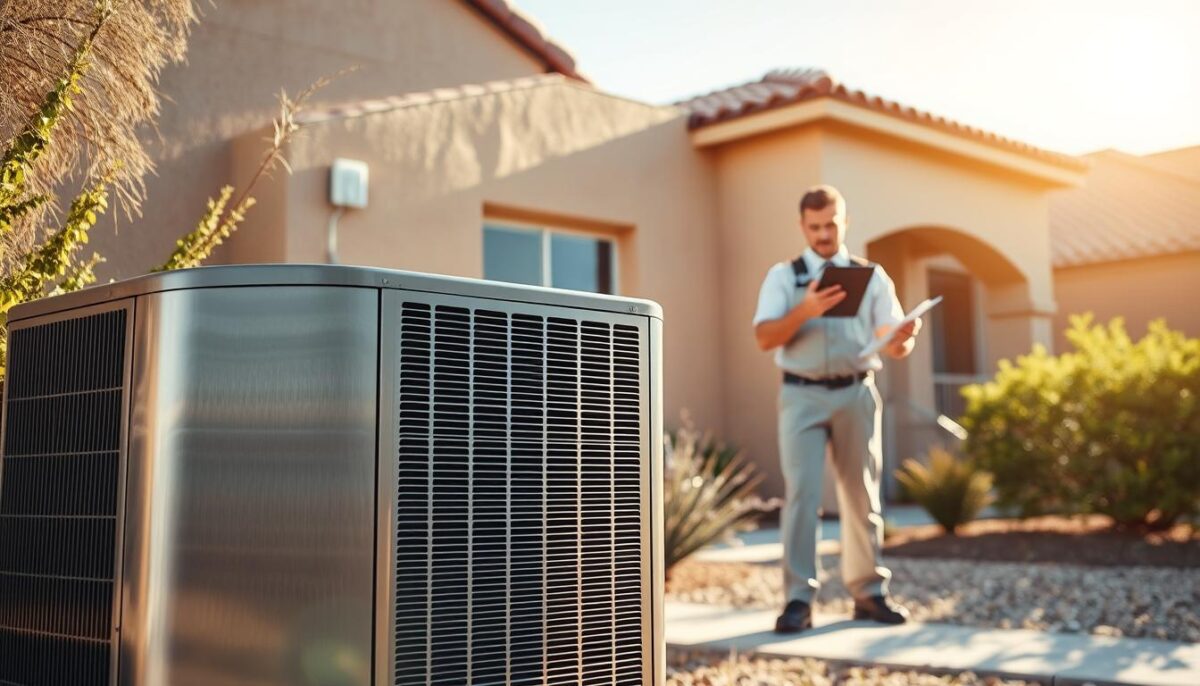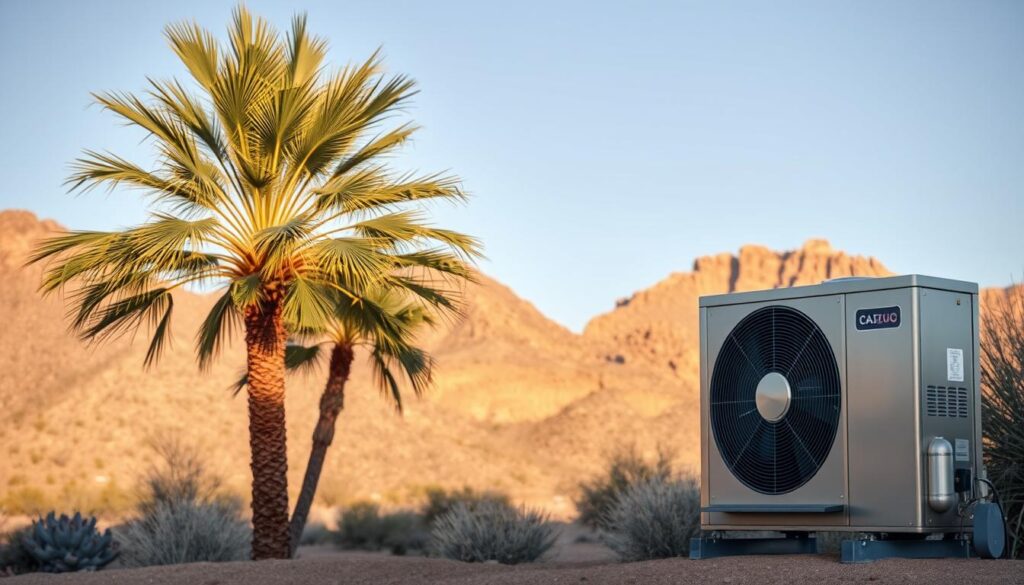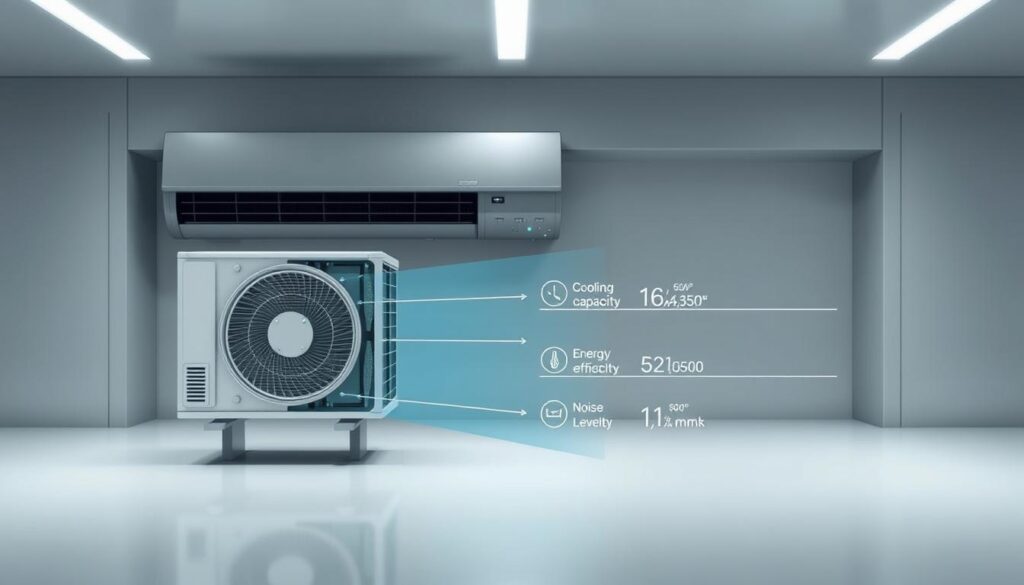AC Replacement Cost in Arizona: What to Expect in 2025

Arizona’s desert heat can be unforgiving, especially when it comes to air conditioning systems. With a typical lifespan of 12-14 years, homeowners often face the daunting task of replacing their air conditioner at some point.
The cost of this replacement can vary significantly, influenced by factors such as the system’s efficiency rating, size, and installation requirements. On average, homeowners in Arizona can expect to pay between $3,000 and $7,000 for a new air conditioning system.
Understanding the current landscape of air conditioning replacement costs is crucial for homeowners planning this significant investment in 2025. This guide will provide comprehensive insights into the factors influencing these costs and help readers make informed decisions.
Key Takeaways
- Average cost ranges for different types of air conditioning systems in Arizona.
- Factors influencing air conditioner replacement costs.
- The impact of Arizona’s climate on air conditioning system lifespan.
- Latest efficiency standards and technological advancements.
- Practical advice on evaluating quotes and selecting the right system.
Understanding the AC Replacement Landscape in Arizona

Arizona’s harsh desert climate makes air conditioning a necessity, not a luxury. The state’s extreme heat, particularly during the summer months, puts a significant strain on air conditioning systems, making reliable cooling essential for both comfort and health.
Why Arizona’s Climate Demands Reliable Air Conditioning
Arizona’s climate is characterized by long, hot summers with temperatures often exceeding 110°F. This intense heat, combined with the dry desert conditions, creates a challenging environment for air conditioning systems. Unlike more temperate regions, Arizona homes rely on air conditioning not just for comfort but as a necessity for health and safety during the hottest months. The harsh conditions accelerate wear and tear on outdoor condensing units, requiring systems that can handle continuous operation for extended periods.
The extreme climate conditions in Arizona mean that air conditioning systems are working harder and longer than in other parts of the country. This prolonged usage can lead to increased maintenance needs and a shorter lifespan for the units.
Average Lifespan of AC Units in Arizona’s Desert Climate
The average lifespan of an air conditioning unit in Arizona is significantly shorter than the national average, typically lasting between 12 to 14 years. This reduced lifespan is due to the constant strain from the extreme heat and the prolonged cooling seasons. Regular maintenance becomes even more critical in Arizona’s climate to maximize the lifespan of your AC system. Understanding this shortened lifecycle is essential for proper financial planning and anticipating replacement needs.
Preparing for replacement before complete system failure can save money and prevent uncomfortable emergency situations during peak summer heat. Many homeowners are caught off guard by the need for replacement, not realizing how the local climate affects their system’s durability.
AC Unit Replacement Cost Arizona: 2025 Price Ranges
Understanding the cost of AC replacement in Arizona is essential for homeowners planning for 2025. The cost can vary significantly based on several factors, including the type of AC unit, its efficiency rating, and the complexity of the installation.
Basic AC Replacement Cost Breakdown
The cost of a new air conditioner in Arizona can range from $6,500 to $17,000 or more, depending on the type and efficiency of the unit. Here’s a breakdown of what homeowners can expect to pay:
- Basic Single-Stage Systems: These systems, with minimum efficiency ratings (14.3 SEER2), typically cost between $6,500 and $11,500 installed.
- Mid-Range Systems: Systems with better efficiency ratings (15-16 SEER2) generally cost between $10,000 and $13,000 installed, offering improved performance and energy savings.
- Premium Variable-Speed Inverter Systems: These high-efficiency systems (17+ SEER2) can range from $13,000 to $17,000 or more, providing maximum comfort and the lowest operating costs.
The total cost includes equipment costs (50-60% of the total), labor (20-30%), and additional components such as ductwork modifications, electrical upgrades, and permits (10-20%).
Regional Price Variations Across Arizona
Regional variations in pricing exist across Arizona due to factors such as contractor density, travel time, and supply chain logistics. For instance:
- Metropolitan Areas: Cities like Phoenix and Tucson may have more competitive pricing due to a higher density of contractors.
- Rural Areas: Installation costs can be 10-15% higher in rural areas due to travel time and limited contractor availability.
- Northern Arizona: Regions like Flagstaff may have different pricing structures due to the need for both heating and cooling systems.
Understanding these regional variations and the factors that influence AC replacement costs can help homeowners budget more effectively and make informed decisions.
Key Factors That Influence Your AC Replacement Cost

When considering an AC replacement in Arizona, several key factors come into play that can significantly impact the overall cost. Understanding these factors is crucial for homeowners to make informed decisions about their air conditioning systems.
Unit Size and Capacity Requirements
An essential factor in determining air conditioner cost is its “size” or capacity. The capacity of your air conditioner affects how well it can effectively cool your home. A unit that is too small will struggle to cool your home, while one that is too large will cycle on and off too frequently, leading to inefficiency and potential premature failure.
Professional HVAC contractors determine the appropriate size through a detailed load calculation that considers factors such as square footage, ceiling height, insulation levels, window placement, and local climate conditions. Incorrectly sized units lead to inefficiency and premature failure, making this calculation critical.
Energy Efficiency Ratings (SEER2)
The efficiency of an AC unit is measured by its SEER (Seasonal Energy Efficiency Ratio) rating, comparable to a car’s gas mileage. As of January this year, government regulations changed the efficiency rating system to SEER2, with a new minimum air conditioner rating of 14.2 SEER2. Higher SEER2 ratings translate to better energy efficiency but also higher upfront costs.
For instance, each point increase in SEER rating typically adds $300-$500 to the system cost. However, the long-term energy savings from higher efficiency units can offset the initial investment, especially in Arizona’s hot climate where AC systems run extensively.
Installation Complexity and Accessibility
Installation complexity varies greatly depending on your home’s configuration. For example, attic installations typically cost more than garage placements due to access difficulties and safety requirements. Homes with limited access points or unusual configurations will incur higher labor costs.
Additional factors like electrical upgrades, permit fees, ductwork modifications, and thermostat upgrades can add 10-20% to the base installation cost. As noted by industry experts,
“The complexity of the installation can significantly impact the overall cost, making it essential to assess your home’s specific needs.”
Types of AC Systems and Their Cost Implications
The type of air conditioning system you choose for your Arizona home can significantly impact both the initial cost and long-term expenses. When considering a new AC installation, it’s essential to understand the different types of systems available and their respective cost implications.
Split System Air Conditioners
Split system air conditioners remain the most common type in Arizona homes. They consist of an outdoor condenser unit and an indoor air handler or furnace with an evaporator coil. These systems are ideal for homes with existing ductwork and offer flexibility in equipment placement.
The cost of split system air conditioners typically ranges between $6,500 and $13,000 installed, depending on efficiency ratings and capacity. They allow for zoned cooling when properly configured but require sufficient space for both indoor and outdoor components.
Packaged AC Units
Packaged AC units combine all components into a single outdoor cabinet, usually installed on rooftops or ground-level concrete pads. This design eliminates the need for an indoor air handler, making them suitable for homes with limited indoor space.
The average cost of a new packaged unit is around $9,500 to $13,000 installed. While they offer simplified installation and maintenance, packaged units tend to have shorter lifespans in Arizona due to constant exposure to the elements.
Ductless Mini-Split Systems
Ductless mini-split systems have gained popularity in Arizona, particularly for home additions or spaces without existing ductwork. A basic single-zone mini-split costs between $3,500 and $5,000 installed, while multi-zone systems range from $6,000 to $15,000.
These systems offer superior energy efficiency and zone control. For more detailed information on installing an AC unit, you can visit HomeAdvisor’s guide on AC installation costs.
Understanding SEER Ratings and Long-Term Savings
As Arizona homeowners prepare for the sweltering heat of 2025, understanding the intricacies of air conditioner efficiency has never been more crucial. The efficiency of an air conditioning unit is measured by its SEER (Seasonal Energy Efficiency Ratio) rating, a metric comparable to a car’s gas mileage. Recent government regulations have changed the efficiency rating system, introducing the SEER2 rating, which provides a more accurate measure of real-world performance.
The New SEER2 Rating System Explained
The SEER2 rating system, implemented in 2023, represents a significant shift in how air conditioner efficiency is measured. With more stringent testing methods, it better reflects real-world performance. Under this new system, a 14.3 SEER2 rating, the minimum for Southwest regions including Arizona, is roughly equivalent to the previous 15 SEER standard. Understanding this change is crucial for comparing units accurately, as manufacturers have redesigned equipment to meet these new standards.
Cost vs. Efficiency: Finding the Sweet Spot
For Arizona homeowners, the sweet spot for SEER2 ratings often lies between 16-18. This range balances upfront costs with long-term energy savings in the hot desert climate. While premium systems with 20+ SEER2 ratings offer maximum efficiency, they come with significantly higher upfront costs that may take over a decade to recoup through energy savings alone.
As “The Department of Energy estimates that upgrading from a 14 SEER to a 16 SEER unit can reduce energy consumption by approximately 13%, while jumping to an 18 SEER system can save around 22%.” This highlights the potential for significant long-term savings with higher efficiency systems.
Calculating Long-Term Energy Savings
Calculating potential savings requires analyzing current energy usage, local electricity rates, and the difference in efficiency between existing and new systems. Arizona’s high cooling demand means efficiency improvements deliver greater savings compared to more temperate regions. Most homeowners can expect to save $100-$300 annually for each SEER point improvement, depending on home size and usage patterns.
Beyond pure energy savings, higher efficiency systems often deliver better humidity control, more consistent temperatures, and quieter operation – comfort benefits that add value beyond mere utility bill reductions. As such, when considering an air conditioner replacement, it’s essential to weigh both the cost and the efficiency to make an informed decision that meets your needs and budget.
Installation Components That Affect Total Cost
Replacing an air conditioner in Arizona involves more than just the unit’s price; several installation components play a crucial role in determining the final cost. Understanding these factors can help homeowners prepare for the total expense of their AC replacement project.
Ductwork Modifications and Replacements
One critical aspect of AC installation is the ductwork. If the existing ducts are not compatible with the new unit’s size, modifications or replacements may be necessary. Properly sized ducts are essential for the unit’s performance, as undersized or leaky ducts can reduce system efficiency by up to 30%, regardless of the AC unit’s SEER rating. In Arizona homes, ductwork modifications or replacements typically add $1,000-$3,000 to the total installation cost, depending on accessibility and the extent of changes needed.
A professional contractor will conduct a duct assessment to determine if the existing ductwork can support the new system or requires sealing, insulating, or complete replacement. Many Arizona homes built before recent energy code updates have ductwork that’s inadequately sized or insulated for modern high-efficiency systems, necessitating upgrades.
Electrical Requirements and Upgrades
Newer AC systems, particularly high-efficiency models, may require dedicated circuits, upgraded wiring, or new disconnect boxes, which can add to the overall cost. Electrical upgrades typically cost $200-$800, depending on the complexity, and can include panel upgrades, new circuit breakers, or bringing older systems up to current code requirements. Not all AC units require electrical work, but when they do, it’s usually for updating the control wiring for the thermostat or installing high-voltage electrical work and breakers around the system.
Line Sets and Refrigerant Considerations
The line sets, which consist of copper refrigerant lines connecting the indoor and outdoor units, may need replacement when switching from an older R-22 system to a modern R-410A or R-32 refrigerant system. New line set installation costs $300-$750 on average but can increase significantly if walls need to be opened or if running new lines presents accessibility challenges. The transition to newer refrigerants has been mandated by environmental regulations, with R-22 being phased out completely.
Additional components like drain pans, condensate pumps, and vibration dampeners add smaller but necessary costs to ensure proper system operation and longevity in Arizona’s harsh climate. By understanding these installation components, homeowners can better estimate the total cost of their AC replacement project.
Labor Costs and Contractor Selection
In Arizona’s sweltering heat, the importance of proper AC installation cannot be overstated, and labor costs are a key consideration. The process of installing an air conditioning system is complex and requires skilled professionals to ensure it’s done correctly.
Understanding Labor Pricing in Arizona
Labor costs typically account for 20-30% of the total AC replacement cost in Arizona. Skilled HVAC technicians can charge between $75-$150 per hour, depending on their experience and certification levels. As such, labor costs for a complete system replacement generally range from $1,500-$2,800 in 2025.
Arizona’s licensing requirements for HVAC contractors help ensure quality, but labor rates can vary significantly between companies based on factors like overhead costs, insurance coverage, and warranty offerings.
How to Evaluate HVAC Contractor Quotes
When evaluating contractor quotes, it’s essential to look beyond the bottom-line price. Reputable contractors provide detailed, itemized quotes that break down equipment, materials, labor, and additional services. Be wary of quotes that are significantly lower than others, as they may indicate corners being cut on installation quality or the use of lower-grade components.
The Importance of Proper Installation
Proper installation is crucial for the efficiency and longevity of your air conditioner. Energy Star estimates that improper installation can reduce system efficiency by up to 30% and lead to premature equipment failure. Therefore, selecting a qualified contractor is as important as the equipment itself.
To ensure you’re hiring a reliable contractor, look for professionals who represent multiple brands and can provide references. Verify that your contractor will pull all necessary permits and schedule required inspections to avoid potential issues with home insurance and future home sales.
Financing Options and Available Rebates
The high upfront cost of installing a new air conditioning system can be mitigated through available financing options and incentives. Arizona homeowners can significantly reduce their AC replacement costs by exploring various rebate programs and financing plans offered by utility companies, manufacturers, and HVAC contractors.
Manufacturer and Utility Company Rebates
Arizona homeowners can benefit from rebates offered by utility companies like APS and SRP, which range from $400 to $1,200 for high-efficiency systems. These rebates typically require installation by participating contractors and minimum efficiency ratings of 16 SEER2 or higher. Major manufacturers such as Carrier, Trane, Lennox, and Rheem also offer seasonal rebates ranging from $500 to $1,500 on premium systems, which can be combined with utility rebates for maximum savings.
For instance, utility rebates can be a significant source of savings. As noted by industry experts, “Utility companies offer substantial rebates for energy-efficient AC units, making it more economical for homeowners to opt for high-efficiency systems.”
Federal Tax Credits for Energy-Efficient Systems
The federal government has extended tax credits for energy-efficient home improvements through the Inflation Reduction Act. Homeowners can claim up to 30% of the costs (maximum $600) for qualified air conditioners through 2032. Heat pump systems are eligible for even more generous tax credits of up to 30% of total costs (maximum $2,000), making them an attractive option for Arizona homeowners.
To qualify for these tax credits, systems must meet specific efficiency requirements, and proper documentation is necessary for tax filing. This incentive not only helps reduce the upfront cost but also promotes the adoption of energy-efficient HVAC solutions.
Financing Plans and Payment Options
Most HVAC contractors offer financing options with terms ranging from 12 to 120 months, often including promotional periods with 0% interest for 12-18 months for qualified buyers. Third-party financing through companies like GreenSky, Wells Fargo, or Synchrony typically offers more competitive rates than contractor in-house financing but may have stricter credit requirements.
When evaluating financing options, it’s crucial to consider the total cost of ownership, including interest charges, rather than focusing solely on monthly payment amounts. This approach ensures that homeowners make the most economical choice for their AC replacement needs.
Making the Smart Investment in Your Home’s Comfort
The scorching Arizona heat makes a reliable air conditioning system not just a comfort, but a necessity. As you consider replacing your AC unit, it’s crucial to look beyond the upfront cost and evaluate the long-term benefits and potential savings.
Investing in a new air conditioning system is about enhancing your quality of life in one of America’s hottest climates. When making your final decision, consider the total cost of ownership over the system’s expected 12-15 year lifespan, including purchase price, energy costs, maintenance requirements, and potential AC repair expenses.
- A properly sized system with the right SEER rating can provide optimal comfort while minimizing energy consumption.
- Research different brands and their reliability ratings to ensure long-term performance.
- Consider how your cooling needs might change over time due to factors like family growth or work-from-home arrangements.
- Don’t overlook the value of maintenance plans, which can extend system life and maintain efficiency.
Advanced technologies like heat pump systems offer excellent cooling performance and efficient heating during Arizona’s mild winters. Additionally, smart thermostats and zoning systems can deliver substantial comfort improvements and energy savings.
Choosing the right HVAC contractor is as important as selecting the equipment. Look for established companies with proven track records and strong warranties on both equipment and labor. Remember, the lowest quote isn’t always the best value; quality installation of appropriately sized equipment from reputable brands will provide better comfort, efficiency, and longevity.



